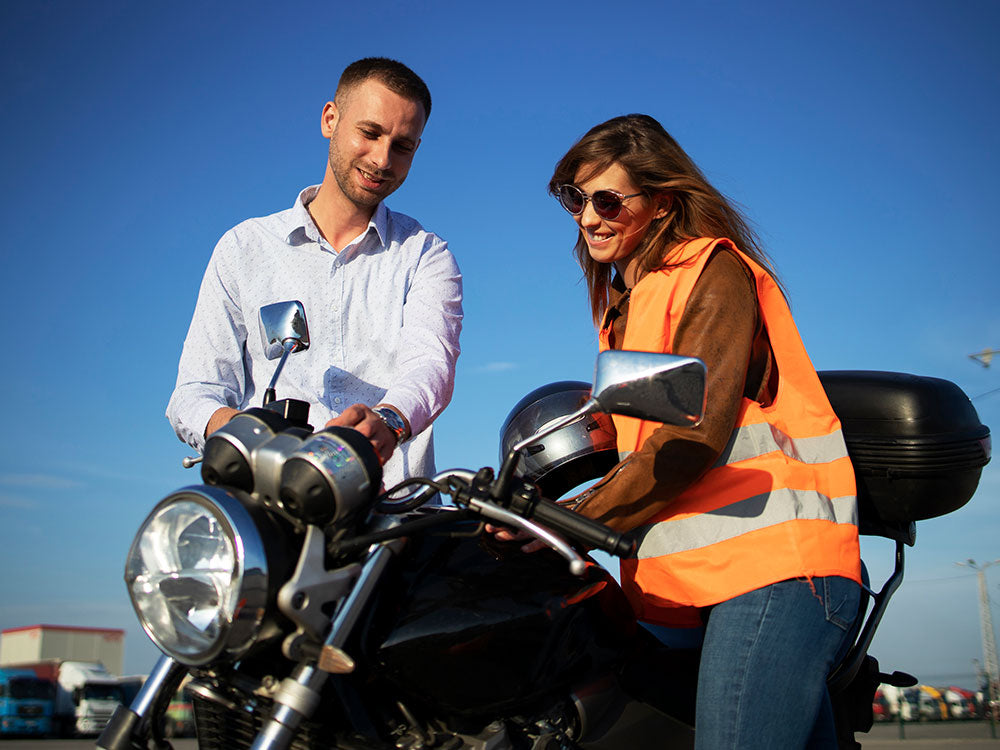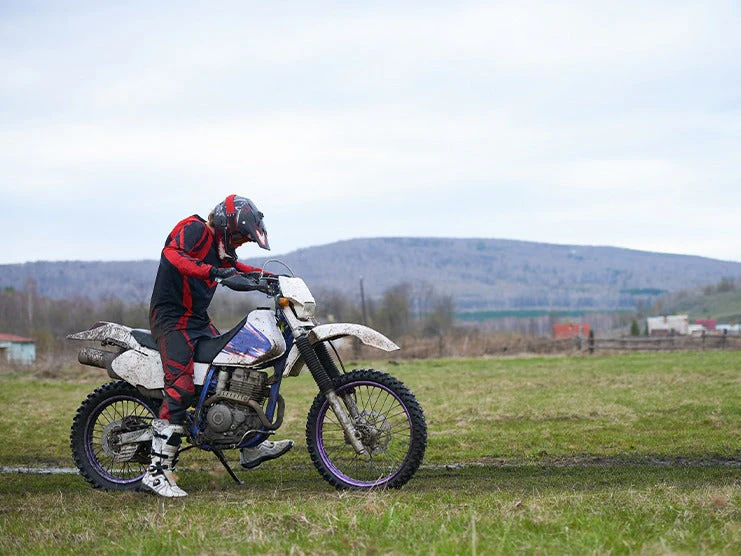Before you can start riding a motorcycle, you need to get a license, complete a motorcycle riding safety course, wear appropriate riding gear, and choose the motorcycle that best suits you. However, to safely ride a motorcycle, there are several riding skills you need to learn. Regardless of skill or circumstance, every rider would benefit from practicing a few safety drills to help them become better riders. This article discusses the seven most important safety drills for motorcycle riders.
Table of Content
1. Balancing and Maneuvering the Motorcycle at Low Speeds

Most motorcycle crashes occur due to speeding. However, even experienced riders find maneuvering at low speeds difficult. If you have a heavyweight motorcycle, like an adventure bike or a cruiser, you may find it difficult to maintain balance, turn tight corners, or make a U-turn.
1.1 Practicing Maneuvers at Low Speeds
Practicing low-speed maneuvers requires knowing how to limit the power output when using the clutch, applying the brakes at the right time, and counter-leaning. You can practice low-speed maneuvers in an open area or a parking lot. You can draw a line or a circle with removable chalk to mark a boundary and practice staying within the boundary.
Counter-leaning is another riding skill necessary to master low-speed maneuvers. To turn a tight corner with a heavyweight motorcycle, you need to lean or shift your weight in the opposite direction of the turn. This helps you balance the center of gravity and the overall weight of the motorcycle.
For a full-lock turn, the rider also needs to gently apply the rear brake to reduce the size of the turning radius. Keep practicing the slow-speed maneuvers by decreasing the radius while riding at low speed. First practice riding slowly in a straight line before transitioning to turns.
LEARNING SLOW-SPEED MANEUVERING AND MAKING U-TURNS
2. How to Safely Turn a Corner

Learning how to safely turn corners can help reduce the frequency of motorcycle accidents. Accidents often occur when trying to turn corners because riders have a limited view of their surroundings and approach at high speeds. Learn how to safely turn a corner by practicing leaning, adjusting your body position, and slowing down when approaching a corner.
2.1 Practice Turning Corners
You become better at turning corners by continuing to practice often. Practice on a lightweight or entry-level motorcycle that is easy to handle. You should also familiarize yourself with the road where you practice.
Do not accelerate while turning a corner as it can cause the tires to lift off the ground and the motorcycle to slip. Slow down before entering a corner by applying the brakes and adjusting the gear depending on your current speed. If you turn a corner at a higher gear, the bike can stall before you have time to switch gears. Rather than accelerate or decelerate while turning a corner, maintain a constant speed.
HOW TO SAFELY TURN A CORNER ON A MOTORCYCLE?
Also Read: HOW TO IMPROVE CORNERING ON YOUR MOTORCYCLE
3. How to Safely Avoid Obstacles
Obstacles, such as potholes, debris, etc, can be dangerous, especially if you cannot spot them until it is too late. Riders need to know how to identify and avoid obstacles.

3.1 Train Yourself to Maneuver Around Obstacles
Riders should carefully scan the road to spot any obstacles ahead. You have to be able to make a quick decision or react at the moment.
Try to avoid the obstacle if you have time. If no other vehicles are approaching from behind, apply brakes. However, if there are obstacles ahead, firmly grip the handlebars, stand on the foot pegs, lift off your buttocks from the seat, and squeeze the motorcycle with your knees. This ensures better control of your motorcycle and reduces the impact of the obstacle. Do not try to accelerate and plow through an obstacle as this can cause the rear tire to slip.
4. How to Improve Reaction Time and Swerve Safely
If an obstacle suddenly appears ahead of you, it can be dangerous to perform an emergency stop since it could cause you to lose control of your motorcycle or cause the vehicle approaching from behind to hit you. In such cases, it is best to swerve instead. Swerving involves suddenly changing directions or lanes. If you are a beginner, you will find it more difficult to swerve since this skill requires a lot of control and practice.
4.1 Practice Swerving
You can practice swerving on your motorcycle by drawing a mark representing an obstacle, then approaching it while riding at a reasonable speed. To abruptly change direction to avoid an obstacle, you need to learn how to countersteer. Suppose you are riding a motorcycle in the left lane at a moderate speed and you spot a pothole ahead. The best course of action is to move into the right lane. Make sure to check the right side mirror and look over your shoulder for traffic before turning into the right lane. Also, turn on the turn signals to indicate to other vehicles what you plan to do. To return to your lane after passing the obstacles, countersteer by turning back towards the left.
HOW TO SAFELY PERFORM HIGH-SPEED MOTORCYCLE SWERVING?
5. How to Make Emergency Stops
Every motorcycle comes with braking systems to help them slow down and stop. However, many riders make the mistake of applying the brakes too quickly Emergency stops are dangerous because you only have less than a second to ease off the throttle, pull the clutch, and apply the brakes. It is best to practice emergency stops and avoid speeding. Most motorcycle accidents occur due to speeding.
5.1 Practicing Emergency Stops
You can practice emergency stops in an open or safe zone where you can safely ride a motorcycle and make stops. Draw a line you should not cross while making an emergency stop. Ride your motorbike at a speed between 20 to 35 mph. Do not suddenly apply the brakes and try getting used to stopping at low speeds. Also, do not immediately pull the front brake lever as this can cause the motorcycle to flip. Making a safe emergency stop requires you to apply the front and rear brakes. Most riders make the mistake of not pulling the clutch lever while applying the brakes. This can cause the motorcycle’s gearbox assembly to become damaged. Only apply the brakes without using the clutch if you are in immediate danger of hitting the vehicle ahead of you.
To safely apply the brakes, ease off the throttle, pull the clutch lever, and apply the front and rear brakes. While making an emergency stop, make sure to downshift into first gear. Keep practicing to improve your braking skills.
6. How to Safely Lean on a Motorcycle
Safely leaning on a motorcycle requires the same skills you learn while turning corners. When leaning on your motorcycle, do not apply the brakes since this can cause the tires to lose traction.
6.1 How to Practice Learning

If you ride a sports bike and want to learn how to safely lean on a motorcycle, first observe how expert riders turn tight corners in real life or in videos. When leaning on a fast motorcycle like a sports bike, you should adjust your body weight in the same direction as the turn. This is known as hanging off a motorcycle. If you hang off a motorcycle properly, you do not need to lean your motorcycle close to the ground.
For a slow motorcycle like a dirt bike, you do not lean in the same direction as the turn. Instead, hang off the side in the opposite direction, shifting the overall weight and center of gravity.
Practice leaning on your motorcycle by placing cones spread apart at equal distances in a straight line and weaving through the cones. As you improve, gradually place the cones closer together and decrease the space you need to weave through.
LEARN HOW TO LEAN A MOTORCYCLE
7. Improve Decision-Making with Mental Training
Motorcyclists should also train themselves to make quick decisions and stay alert at all times. When riding a motorcycle, you need to be on the lookout for potential threats and react accordingly.
You also have to learn to tune out any distractions. Studies revealed that more than 3,000 people died in fatal road accidents in the U.S. due to riders using their cell phones in 2020.
7.1 How to Do Mental Training
The first thing a rider should do to train his/her mind is to take safety classes and training sessions. These sessions help teach riders to have better awareness when on the road.
Before embarking on a motorcycle ride, make sure to stay relaxed and calm. Do not go for a ride if you are stressed. Physical health can also help improve your mental health. Doing light exercises and walking can improve your mood and reduce stress. A study has shown that morning walks are the best light exercises to help improve blood flow throughout your body and has a positive effect on your brain functionality.
Eating the right diet ensures you get the essential nutrients you need to improve brain functionality. If your body’s sugar levels are stable and you consume enough glucose and carbs, this will help keep your mind active.
Also Read: MENTAL HEALTH BENEFITS OF MOTORCYCLE RIDING
8. Takeaway
Motorcycle riding is a fun activity. However, safely riding a motorcycle requires learning essential skills to reduce the risk of putting yourself and others in danger. A rider needs to get a license, choose the right motorcycle that best suits his/her current riding skills, complete riding classes, and training sessions, and wear appropriate riding gear before being ready to ride a motorcycle.
When riding through traffic, maneuvering twists and turns, or cruising on highways, you will need to know how to corner, swerve, lean, and make emergency stops. Without these skills, you cannot become a good motorcycle rider. Training yourself by performing the safety drills covered in this article will promote safer motorcycle riding.
If you learn emergency riding skills, like making emergency stops, maneuvering at slow speeds, turning tight corners, and leaning on a motorcycle, you can lower the risk of crashing. Also, good mental health and a proactive mind can be just as important as good physical health.













Leave a comment
All comments are moderated before being published.
This site is protected by hCaptcha and the hCaptcha Privacy Policy and Terms of Service apply.